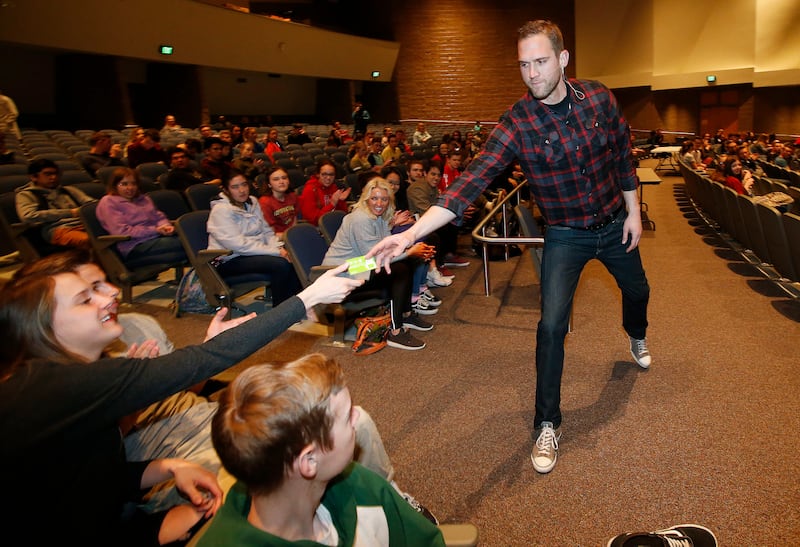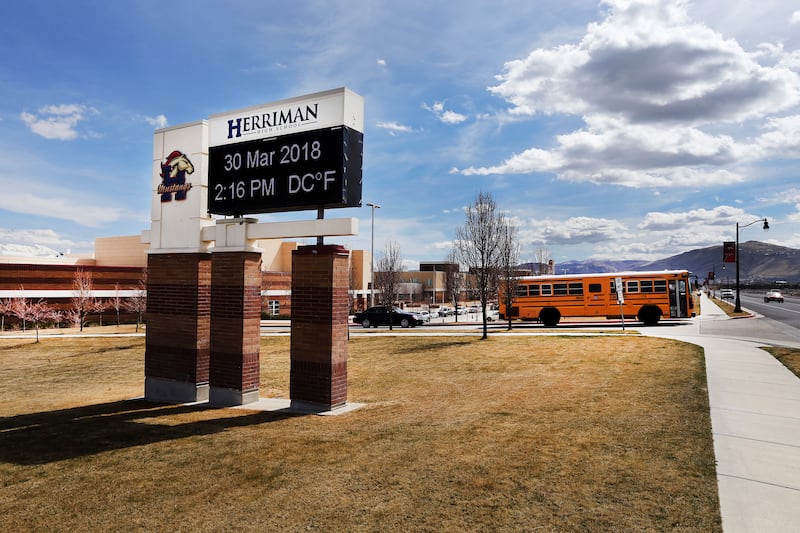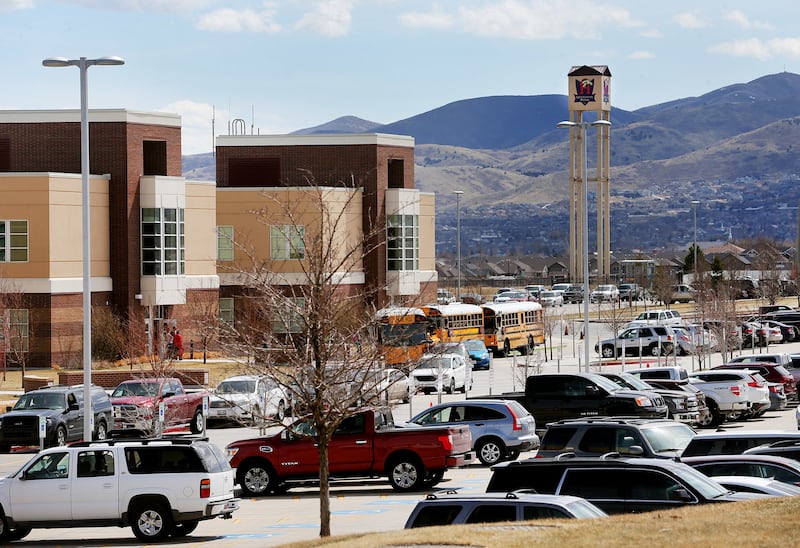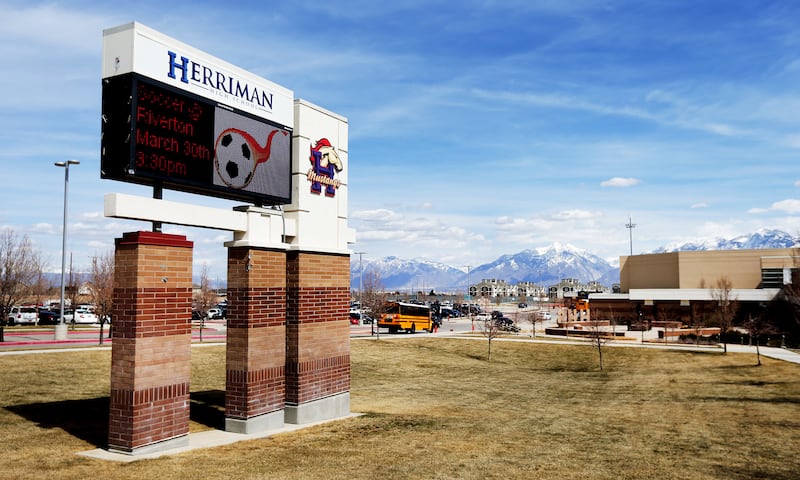HERRIMAN — In the past year, five students have died by suicide while enrolled at Herriman High School, and community members are trying to cope with an especially pronounced version of a statewide crisis.
A Jordan School District representative confirmed the number of suicides after anecdotal reports were shared this week at a school board meeting and on social media, and state and local officials announced a multiagency response team Friday.
In addition to those five students who died by suicide, a Herriman senior was killed in February when his car rammed a school bus that was stopped at a traffic light.
"Our community is hurting," said Herriman Mayor David Watts. "It's being felt. And we take it extremely seriously, and we are concerned with the situation, and — sometimes you don't know what to say, because it's hard to deal with this kind of tragedy. But at the same time, we want everyone to know that there is always a place to turn, there's always a person to talk to."
In a community of some 35,000 people, it's difficult to find students or adults who haven't been touched by these events in some way.
Erin Preston, the mother of a Herriman High School student and a middle schooler who attends a school that feeds into the high school, told members of the Jordan Board of Education earlier this week that the community needs to talk openly about what has transpired in the past year.
“You are way past not being able to talk about this now. The kids are talking about it. The teachers are talking about it.
"Talk about it. They want to hear you talking about it. They want to hear the administrators talking about it and acknowledging it as a problem. I understand that in suicide issues that sometimes talking about it can make it grow. It’s too late. We need to talk,” said Preston, who practices education law.
Darrell Robinson, who represents Herriman and part of Riverton on the Jordan School Board, acknowledges it has been a trying year. His daughter attends Herriman High and was close to one of the students who died.
Robinson has strongly encouraged his daughter to talk to crisis counselors and use other resources offered by the school district.
"I'm not an expert about advice to give to her," he said, adding that he and his wife have been open in talking about the students' deaths. "Hopefully everyone is. Certainly we're worried."
More resources
A 2017 study involving the Centers for Disease Control and Prevention found that from 2011 to 2015, the frequency of youth suicide in Utah rose 141 percent to 11 per 100,000 youths — more than 2.5 times the national average. Forty-two Utahns age 10-17 died from suicide in 2017, according to preliminary data.
Gov. Gary Herbert responded in January by creating a state suicide task force, which then released recommendations in February that inspired a handful of related bills during the recent legislative session.
Task force co-chairman Rep. Steve Eliason, R-Sandy, said the Legislature has allocated more than $7 million in new funding, including support for mental health hotlines and five new mobile crisis outreach teams that can respond to patients at their homes.
Holly Bell, who oversees school counselors for the Jordan School District's secondary schools, helped lobby for one bill passed by lawmakers that will provide more than $2 million in matching grants to hire more elementary school counselors. It is a critical need because early interventions such a teaching kids coping skills can head off challenges later in their school careers and in life, she said.
But at the same time that state leaders were pledging unprecedented resources to reducing youth suicide, Herriman High was shaken by two suicides in the summer — one involving a middle school student who would have started at Herriman High in the fall — and three more during the current school year.
Since January 2017, officers from Herriman’s Unified Police Department precinct have responded to seven suicides by people under 20. Five of those have involved people under 18.
Bell said she has observed a school community that has deepened its resolve to support students, staff and families.
"It is tragic, but what I'm hearing is, 'I'm going to go to work because I'm going to make a difference,'" she said.
'Connecting with students'
Any time there is a traumatic event such as the death of a student, the school district dispatches a mobile crisis team to work with students throughout the school day, Bell said.
In the days and weeks that follow, counselors at the school continue to meet with students in groups or individually, depending on their needs.
Students who need more specialized care are referred to mental health care providers in the community such as Salt Lake County Youth Services Center, theFamily Counseling Center or Valley Behavioral Health. Support services and classes for students and parents are also offered by the Jordan Family Education Center.
Presently, Herriman High has nine school counselors and a school psychologist — the most of any high school in the Jordan School District, Bell said. All school counselors in the district have crisis training, so they work with mobile crisis teams sent to their schools when traumatic events occur.
Part of Bell's job is to nurture counselors who help students cope with the sudden deaths of their peers or other crises.
"I'll go out and bring them food and ask them what their needs are," she said. Self-care is important because the counselors need to bring their best selves to the job of caring for students.
"They're connecting with students they care about. It's heartbreaking when you see your students suffering," she said.
Teachers, too, are strongly encouraged to seek counseling offered by the school district. Preston told the school board about a teacher who visited a student at the University Neuropsychiatric Institute after a suicide attempt.
"It was a serious attempt. It was very close," Preston said. The teacher "did the hard thing. He showed up and said, ‘I care about you’ at the most awful of times. She’ll never forget that."
Robinson said he's aware of many people in the school community who have intervened with students who considered harming themselves. No one keeps track of those interventions "and it's not like we're keeping score."
"One life (lost) is too many," he said.
The Jordan School District reported that about 600 people participated in a November "Hope Walk" for suicide awareness at Herriman High, which is Utah's third-largest high school with over 3,000 students.
On March 13, former University of Utah, Weber State and NBA basketball player Lance Allred addressed students and parents about the challenges involved in overcoming obstacles.
And in a video created by the school's student-led Hope Squad posted to YouTube on March 16, Herriman school staff addressed students with personal accounts of their own life struggles, telling students: "We get it."
School district spokeswoman Sandra Reisgraf said the district has scheduled meetings and trainings led by national suicide prevention expert Scott Poland, who will address students, teachers, administrators and parents districtwide. A meeting for families will be held April 16 at Riverton High School.
As spring break approaches, students will be referred to community resources until school resumes on April 9, Reisgraf said.
Avoiding glamorization
Utah Department of Health spokeswoman Jenny Johnson said Friday that state and local health officials "are reviewing data to further assess the situation, but more importantly, working to ensure suicide prevention resources are available to the impacted communities."
Responding to suicide can be a particular challenge for school officials, who have a handful of considerations to balance.
In 2011, the American Foundation for Suicide Prevention and Suicide Prevention Resource Center published a toolkit for schools responding to a suicide
Most administrators know to avoid glamorizing suicide. Highly visible memorials or schoolwide assemblies can send the wrong message to other suicidal students that suicide will get them the attention they may crave.
Michael Staley, the state medical examiner's suicide prevention research coordinator, said a worst-case scenario is the treatment afforded the central character in the Netflix show "13 Reasons Why," who commits suicide.
“Across the country and even here in Utah, we’ve seen students echo that,” Staley said. “They say, ‘I want an assembly in my honor. Please decorate my locker.’ It’s a very romantic idea of suicide.”
But at the same time, experts say administrators should avoid stigmatizing mental illness by treating a suicide differently from other deaths in the school community.
"Schools tend to underreact" because they fear glamorizing suicide, said Joanne L. Harpel, president of Coping After Suicide in New York, and one of the authors of the suicide response toolkit.
Information about suicides should be spread in small groups, experts say. That way, educators and counselors can closely observe the effect of the information on students. And to ensure that the messaging is consistent, schools should have a policy in place before the need arises to respond to a suicide, experts say.
The subject of suicide contagion — where one suicide appears to contribute to another — can be controversial. Suicide is generally the result of a variety of complex factors, and 9 out of 10 people who commit suicide have some sort of psychiatric disorder.
In a written statement to the Deseret News, the Centers for Disease Control said that “limited scientific evidence exists to support contagion.” The CDC has worked with communities to identify suicide clusters, but “given how vague the concept of contagion has been and the limited evidence to support it, it has always been difficult to empirically assess it.”
“It’s not that someone is going to become suicidal just because there were other suicides in the community,” Harpel said.
Kim Myers, suicide prevention coordinator for the state Department of Human Services, said suicide isn't "contagious in the way that Ebola is contagious." And while contagion effects have been observed after suicides — including media reports of celebrity suicides — Myers said that positive, resilient responses to challenges can be similarly contagious among groups of young people.
But “the fear that there’s a contagion is a completely different animal," Harpel said, "and that you do need to address.” After multiple youth suicides, adults tend to become "very, very afraid" of the subject, she said.
"Students are talking about it, anyway," she said. "What you want to do is to have whatever information is out there come from the most reliable, accurate source possible."
Staley said that misinformation about groupings of suicide "creates this whole big cloud of trauma, and we know that that increases the likelihood of other suicides."
Harpel said it's a myth that asking somebody if they're having suicidal thoughts will "put the idea in their mind." It's especially important that parents talk to their children, she said, and that they watch for behavioral changes like eating more or less than usual, sudden dips in grades or withdrawing from social activities — particularly when they occur for two or more weeks.
Whether students are struggling with grief or are thinking about harming themselves, Bell said, they need to be reassured that they have trusted adults in their lives who will listen to them and will help.
"They don't always want to tell their parent so tell them, 'If you don't want to come to me, I know there are people you can talk to at school. You've got a counselor you can go to. You've got teachers that love you,'" she said.
***
Help available
If you or somebody you know is experiencing suicidal thoughts, you can call the 24-hour National Suicide Prevention Lifeline at 1-800-273-TALK or text “HOME” to the Crisis Text Line at 741-741.
Utahns with smartphones can also download the SafeUT app for around-the-clock counseling and crisis intervention.









